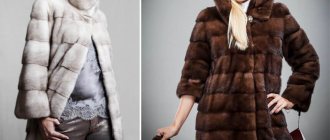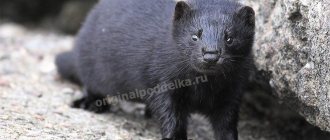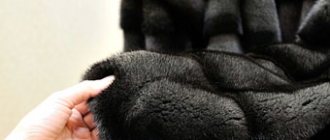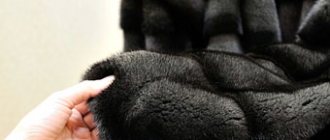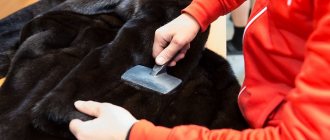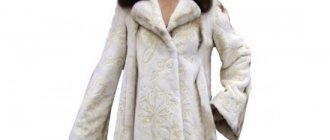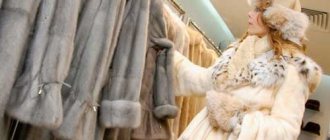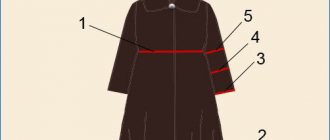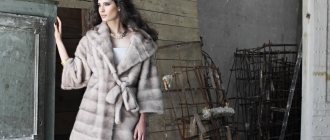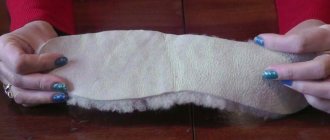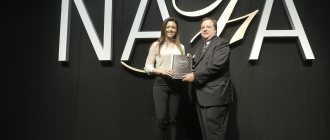12 Feb 2019
When buying fur outerwear, you may encounter a problem that unscrupulous sellers try to pass off an ordinary cheap fake as real mink. There are even “high-quality” options, when the buyer remains confident for some time after the purchase that he has become the owner of a real mink. But there are few of them. As a rule, you can distinguish the real skin of an expensive animal from fake dyed fur after the first contact with precipitation: at best, the cheap one will simply shed, at worst, it will shed and lose its shape, turning from a prestigious fur product into a large ball of wool. To prevent this from happening, you should know how to distinguish natural fur skins from high-quality and low-quality analogues.
The main differences between natural mink
Mink is highly valued in the world of fur products along with lynx and chinchilla. Every woman with refined taste and high demands in life dreams of having such a thing in her wardrobe. The fur of this animal is beautiful and durable, it looks expensive, presentable, and besides, it is really warm. A mink coat is characterized by excellent wear resistance: even in harsh climates, the wear life of the product is at least seven years, and with proper care it doubles. The quality and service life are affected by the age of the fur, what part of the skin is used (from the back of the fur coat is more expensive, from the belly and frontal part - cheaper) and the type of animal (European, American, Scandinavian and others). It is recommended to buy mink coats only in specialized boutiques, where the likelihood of encountering a fake is minimal. But even in a fashion boutique, the product should be carefully inspected and studied before purchasing. There are several criteria by which you can distinguish mink from a fake. It is equally important to be able to distinguish a mink from a rabbit and other animals by their fur. After all, fur is different from fur, and even a natural rabbit costs several times less than mink.
Final table
To distinguish natural fur from artificial fur, you should pay attention to the criteria given in the table:
| Criterion | Natural fur | Artificial fur |
| Shine | Shines and shimmers | Features a matte surface |
| Weight | Easy | Heavy |
| Compactness | Easily folds and takes up minimal space | More bulky |
Natural mink must meet many criteria by which its authenticity can be distinguished. At the same time, it is important to approach quality assessment comprehensively.
Which animals' fur becomes fake?
Mink fur is quite expensive.
To earn more, some unscrupulous sellers pass off fur coats made from rabbits, marmots and other animals as mink products. To do this, the fur can be cut, dyed, etc. But if the appearance of a fur coat can be easily changed, then it is not so easy, even impossible, to influence the properties of the fur. Different animals have fur that has its own distinctive features, which will help you distinguish a real mink from a fake. Instead of mink, scammers most often offer skins from:
- A rabbit. It has a very soft pile, the color is not the same and not uniform along the entire length of the product, and if you stroke the fur with your hand, lint remains on the palm.
- Beaver. It has fairly hard fur and a very thick interior.
- Groundhog. If you stroke the fur against the growth of the pile, it will become shaggy, since its plasticity index is minimal. In the sun a blue tint appears, the fur has different lengths.
- Ferret. The main difference is the color: the fur at the ends is darker, and the underfur is light. Only straight products are sewn from ferret fur, since in other cases the seams will be visible.
- Honorica. It is very difficult to distinguish the fur of natural honorica. The only thing that gives this animal away is its black color with a thick brown undercoat. Otherwise, this is the most perfect fake, because this animal was bred by crossing with the participation of mink.
In addition to natural animal fur, artificial fur coats can also act as fakes. Moreover, in response to the buyer’s remark that a mink coat looks strange, inventive scammers refer to the fact that this is a type of animal.
What is the difference between tailoring fur coats from Chinese and Scandinavian mink?
High-quality Scandinavian fur coats have fairly high-quality tailoring. Accordingly, all pieces of skin are carefully connected to each other. Sew-in of small leather areas is allowed. The fewer such areas, the better the quality of the fur coat. In addition, coloring is not permitted. The same cannot be said about Chinese models.
Sewing and patterns:
- The fact is that the Chinese are trying to pass off one type of mink as another, and accordingly they can cut it and also dye it. This is quite easy to notice if you look at the reverse side of the fur coat. If the fur is not dyed, then the mink is brown, black or mahogany. At the same time, the reverse side is much lighter than the color of the fur itself. Chinese fur coats are often dyed black.
- Thus, the skin itself, that is, the flesh, is painted dark gray or black. This is not the case in Scandinavian fur coats, and a high-quality black mink coat has a light brown tint on the reverse side. Just like any light fur coat. This is due to the fact that Scandinavian minks are not dyed, but are sold as they are in color.
- Recently, quite often, Greek companies, in order to save money, order fur coats made from European skins in China. Then it is necessary to consider not the skin itself, but the method of joining, as well as the model and tailoring of the fur coat. Very often in China they mess around and start sewing this kind of clothes rather poorly. To be more precise, the distance for connecting the mink pieces is not maintained.
- Thus the seam can be thicker or thinner. This does not happen with Scandinavian fur coats, since almost all the skins are sewn with the same stitch and are of the same thickness. And also Chinese fur coats do not have a huge range of models, that is, patterns. They usually have the same model range, which is the most popular. As for Scandinavian models, here you can choose a fur coat to suit every taste and figure.
Fur coat from China
Distinctive features of different types of mink
Depending on the origin (where the animal was raised), mink fur has a number of distinctive characteristics.
Thus, Russian mink is found mainly in long coats. The fur looks slightly shaggy, but has a natural shine and is silky to the touch. The pile is quite long and the undercoat is high. This fur coat is very warm, it can withstand any frost, warming its owner. You can distinguish it from a fake by the height of the middle layer of wool, which is significantly higher than the down. The Belarusian and Baltic species have the same characteristics as the Russian, although they are grown in other regions.
The most popular type of this fur animal is the Scandinavian one. This type is grown in Finland and Scandinavia. Depending on this, the fur can be low or high, but the undercoat is always very thick. There is another Scandinavian type of this animal, the so-called “polar”. Visually, this fur is more reminiscent of sable, since the pile is long, brown, and quite expensive. It is very warm, waterproof and has a wide range of colors (various shades of dark brown, up to black brown).
The North American species is represented exclusively by black fur. This fur is considered the most expensive, it is of impeccable quality, its underfur is very thick and dense. The pile in such products has a beautiful appearance, it is low and silky, in many ways reminiscent of velvet.
The most affordable in terms of pricing policy is Chinese mink fur. He has a long pile and a thick undercoat. Due to its high popularity, it is extremely rare to find original Chinese fur; fakes are becoming more and more common. All products are cut and can be dyed.
What to do before buying
See also:
Counterfeit screwdrivers - how to distinguish them from the original
To avoid buying a fake or low-quality product, there are several simple but effective tests.
Conducted immediately before purchase.
- Shaking test
. If, when shaking, the fur coat rattles and also rustles, this indicates overdrying and a violation of the dressing technology. The fur coat should not rattle or make noise; - Blow on the pile
. Feel the entire surface. With such a test, softness and absence of creases should be observed. If there are creases in the flesh, holes quickly form because of them. The product will wear out in 1-2 seasons; - Palm on the fur
. Or gently pluck the lint. If there is nothing left in your hands, this is a good sign. Do not believe that shedding fur is a sign of long-term storage. Villi fall out only due to a violation of production technology, as well as due to the extraction of animals during the molting period; - Appearance
. The color should be the same, uniform; - Napkin test
. Take a damp white napkin. Swipe over clothing. If the napkin is stained, then it is a fake. Or in some places they masked defects in the skin; - Take a sniff
. No chemical smell. No rotten animal fat feeling. In the first case, it is an artificial fur coat, or dyed. In the second, the manufacturing technology was violated; - Armpits
. If they are wrinkled, this indicates the presence of a previous user. This coat has been used before. Sold as new; - Label
. Study the information on the label. This includes the serial number, country of origin, address and contact information. If there is no information about the manufacturer, you should not buy it.
Try to make such purchases in reliable and trusted places.
How to perform a fur assessment yourself?
A fake mink coat can be distinguished by a number of criteria. But to do this, you need to try the product by touch and carefully examine it from all sides.
- Try the fur to the touch. Not only touch it, but squeeze it in your fist, rub it. High-quality fur should be smooth and soft, but it will itch quite a bit. But rabbit fur does not prick at all (it can be distinguished from others by this criterion), it is very soft, but less wear-resistant. The pile should be pliable, but always return to its place after you run your hand over it. It is worth considering that if the fur is of high quality, it does not need dyeing or cutting. Such manipulations serve only to hide defects, but not to follow fashion. Only natural furs have always been and remain the most fashionable. Assess the undercoat. The mink is divided into winter and summer. The winter version is warmer, has a thick undercoat, and is cheaper. In summer-type fur, the opposite is true: the coat is smooth and shiny, and the undercoat is smaller. This type of fur is more expensive.
- Check the age of the fur. This can be done using the flesh. The light and elastic lower part of the skin indicates the youth of the fur, and the darker it is (even brown), the older it is.
- Visual assessment. The fur coat must have a uniform and even color, which makes it possible to distinguish a quality product. If the clothes are sewn from the back of the animal, then in appearance it will seem that the product is cast; if from the belly and other parts, the fur coat will seem to be sewn from small semicircles.
- Be sure to look under the lining. A quality item must be of high quality in everything. The lining must be sewn correctly: not too tightly, but not loose. The seams should be smooth and neat, and the edges should not stick out or protrude. And most importantly: with high-quality fur clothing, you can always look under the lining to evaluate the inside of the product. The fur on the inside should be white. It happens that during the manufacturing process it is overdried, then the underside of the fur becomes like tissue paper. This appearance may also indicate old age or stretched fur. At the first severe frost, the fur coat may immediately fall apart.
- Be careful with painted items. For some women, the fact that a fur coat is dyed is not an obstacle to purchase. But purchasing such products, as in the case of undyed fur, should only be purchased from a trusted seller who has the appropriate quality certificates. Otherwise, the dye from the fur may transfer to the clothes: with the first snow or rain, it will simply flow.
- Knowing these secrets, the buyer himself can evaluate the quality of the fur, which will help him distinguish a real mink coat.
Lining quality
When purchasing mink fur outerwear, it is important to pay attention not only to the condition of the fur, but also to the lining. If the product is really high quality, then you should pay attention to the following points:
- Made from material that is highly durable and of excellent quality. Most often natural silk is used.
- Exactly repeats the cut of outerwear. When worn, movement is free, and the fur itself does not bristle.
- The lower part of the outerwear is loose and not attached to the fur coat. You can get to the underside of the skins without much difficulty.
- The seams are processed with high quality, they are distinguished by smooth lines and durability.
- There is a cord trim around the edge.
How to distinguish a mink coat from a fake in practice?
The difference between a mink and a fake begins with its cost.
If they make you a very lucrative offer, offering a crazy 50-70% discount on a fur product (supposedly due to a sale), look for a catch - most likely, they are selling you a fake. The fur of an expensive animal cannot be cheap. The cost of the finished product, in addition to the cost of the fur itself, also includes the cost of tailoring, and working with fur, especially natural, requires a certain skill, which is also assessed accordingly. It is not recommended to buy fur products in unknown online stores without the right to try on and check the fur, where the buyer can distinguish a fake only after the purchase.
How can you verify the quality of a mink coat in practice? Here are a few life hacks on how to distinguish a mink coat from a fake:
- Shake the product, squeeze its edges, crumple the fur. This way you can determine whether the fur coat is rattling or whether it has been overdried.
- Examine the fur for creases. If they are present, this means that the product has holes.
- Gently tug the lint. It shouldn't be left in your hands.
- Check your armpit area. They should not be soft, as this indicates that someone has already worn this outerwear.
- The mink should have a uniform color. Otherwise, it is either faux fur or the hair of another animal.
- Try wiping the fur with a white napkin. Any traces on its surface will confirm that the product has been painted.
- Smell the fur. The smell of chemicals or dried animal fat may indicate that the fur processing process has been disrupted.
- Inspect the seams. They should be smooth and strong, using an elastic thread; ideally, the lining is sewn by hand.
- Check the label. It should contain detailed information about the country and place of production of the fur product, as well as contact details of the manufacturer.
Knowing how to distinguish a fake, you can purchase a quality product that will last for many years, decorating you and keeping you warm in any weather.
Operation and care
Any item reflects the care given to its owner during use. The service life of a mink coat during dissolution will be extended, and its appearance will be preserved if it is treated with care and properly cared for.
If your mink coat has been exposed to precipitation during dissolution, it is best not to try to save it with a hair dryer or other devices, but to let it dry quietly in a cool, dry room. Never straighten dried fur with a comb; shaking the product several times will be enough.
Try not to carry bags or backpacks over your shoulder. Fur creases may form in this area over time (even with high-quality fur coats).
To store mink coats for dismantling during the warm season, some cities have special refrigerated storage facilities where you can return the item for a subscription fee. If such a service does not exist in your city, then for storage it is best to place the fur coat in a breathable dark-colored case and put it in the darkest and coolest place in the apartment. Sprinkling with mothballs or anti-mole preparation is not recommended. Place this medication in your pockets, wrapping it in gauze.
While the winter season has not yet arrived, but the weather is cloudy and humid, it would be a good idea to hang your fur coat on the balcony so that the skin and fur are saturated with moisture and are more elastic.
A mink coat should not be dry-cleaned, but if this is necessary, dry cleaning should be very delicate.
Criterias of choice
When planning to buy fur clothing, you need to answer some questions for yourself . An important role in this case will be played by the appearance and body type of the future owner, her lifestyle and fashion trends. You should not discount your material well-being, as well as the opinion of experts.
Think about the purpose for which you plan to buy a fur coat? Will it be clothes for every day or for “getting out of the limousine”.
Think about how you will wear this fur coat . A model for traveling on public transport and for going out are not the same thing.
In addition, decide how much you can spend on such a purchase and where exactly you will purchase it. If you are a resident of Siberia or another northern region, it is better to give preference to warm varieties of mink and elongated clothing models. Residents of the southern regions can also consider shorter models made from light varieties of fur.
Active car ladies will feel uncomfortable in a toe-length fur coat. In addition, such an outfit will very quickly lose its attractiveness.
For frequent trips on minibuses and the subway, you should not choose light-colored clothes.
How to choose a mink coat? Expert advice will help you avoid mistakes and buy a truly high-quality product.
